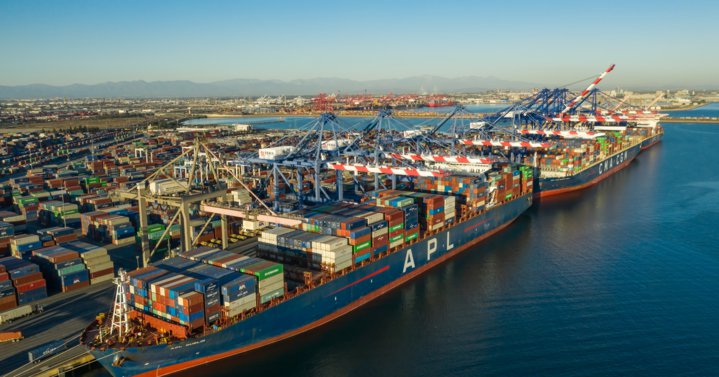
The supply chain continues to experience massive demand fluctuations as e-commerce surges swell and peak season begins. According to The Washington Post, the ports of Los Angeles and Long Beach have made national news as container ships await docking. This is a new challenge for the supply chain, and it heralds the important role of staying informed as day-to-day events unfold. While understanding the differences between FCL and LCL shipping can help your company stay strategic, it’s always vital to understand the overall flow of goods in the market and what’s making waves, pardon the pun, in terms of rates and demand. Let’s take a closer look at what’s happening in the industry and what it means for the value of a digital freight marketplace in securing capacity and planning shipments around ocean import news.
Container Throughput Volumes Soar
The biggest ocean import news in the industry is the massive gains in demand across U.S. imports. The FreightMango team has worked to aggregate publicly available Drewry data, specifically the Drewry World Container weekly index updates, to better understand the strain on ocean shipping as of June 2021, the most recent reporting of volumes from Drewry. The data reveals that container throughput volumes have surged across most ports as follows:
- Global container volume shipped has risen 3.7% since 2020, yet only 1.3% over 2019 levels.
- China has seen its throughput index hit 147.7, 2.0% higher than in 2019.
- Throughput at North American ports has skyrocketed well, rising 12.5% over 2020 and 5.8% over 2019 levels.
- Latin American throughput is 14% higher than in 2020 and 6.6% higher than in 2019.
- Europe activity is also 5.5% higher than in 2020, but slightly less, 3% lower than in 2019.
While these changes in volume may seem minor, the increases lead to massive delays as higher volumes were processed across specific ports:
- The Port of Los Angeles hit 876,430 TEUs in June 2021, according to Reuters.
- The Port of Los Angeles has also seen a 30.34% year-over-year change in volume, moving 1,692,942 more containers in 2021 than in 2020.
- Container trade at the Port of Long Beach has moved 6,865,396 total TEUs, a 27.5% change over 2020.
- The Port of Long Beach has also moved 807,704 containers in August, a 21.9% increase over the July total of 784,845 TEUs.
The Port of Long Beach has not yet reported September statistics, but there iss clear evidence that activity is moving well above all predictions.
Of course, understanding volumes is only half of the battle; the rest is understanding ocean spot rates.
Ocean Rates Are Rising in Tandem With Demand
The additional volume of imports has also had an interesting impact on ocean container rates related to ocean import news as well. The Freightos Baltic Index for China to North America East ports, which measures the daily pricing of a 40-foot container, is sitting at $19,421, compared to $4,684 in 2020. More troublesome than the average increase is the range of rates from China to the East Coast, which varies from the lowest cost of $9,644 to the highest of $32,513.
Rates from China to North America West Coast have dipped to $16,004 on average, from a high of $20,586 on September 10.. This is slightly ironic, as demands have become even more burdensome on West Coast ports in recent weeks.
The massive increase in demand has driven prices upward, but this data doesn’t consider the fact that U.S. West Coast ports are experiencing record-setting delays right now. This is simply due to the reporting periods for which Freightos and Drewry release data, roughly a week and one-month behind the current activity level.
The Drewry World Container Index is also at near-record levels and is publicly updated more often than Drewry rates. The composite index decreased slightly by 2.3% as of October 14, 2021, but it’s still 283% above 2020 levels, which were still higher than in 2019 due to the pandemic-e-commerce expansion. Remember that this index measures average rates across the eight major trade lanes on the planet, and current rates put the average cost at $9,900. Additional considerations for rates coming from Drewry include:
- Shanghai to Los Angeles is now at $10,898, a 2% decline week-over-week, but still 168% higher than in 2020.
- Shanghai to New York is down 7% as of October 14, 2021, but is still 188% higher than in 2020.
- Rotterdam to New York average hasn’t changed in the past week, but at $6,200, it’s still 191% higher than in 2020.
What This Means for US Importers
Ocean rates are volatile and reflect the state of demand and capacity availability beyond actual ships. Consider, for example, delays in OTR transportation that will inevitably create delays in ship unloading and the return of empty containers. This means US importers need to think more strategically about their sailings and determine which ports of origin and destination will be best able to accept cargo, get it unloaded quickly, and return empty containers across the sea. Further, it’s not enough to try to sort through each lane’s rates on a day-by-day basis. Doing so in-house would cost countless dollars and lead to massive delays in actual management of top-priority freight. That’s why organizations have been turning to experts to handle the full view of all ocean container procurement and management needs. In fact, this is specifically what a freight marketplace, like FreightMango, does best - compiling real-time rates and capacity on tough trade lanes and bringing them directly to the shippers who need them.
Get on the Path Toward Ocean Import Stability With FreightMango
The simple reality is that importers can only do so much. Even as more companies look to join the ocean freight landscape and Amazon FBA becomes a new gold standard for ease in fulfillment, there are numerous ways that a digital freight marketplace can help your company. Stop wasting time trying to figure out the complexities of international container rates; let the experts do the hard work for you. Connect with FreightMango to get started now.





 Get instant quote
and compare offers in real time
Get instant quote
and compare offers in real time